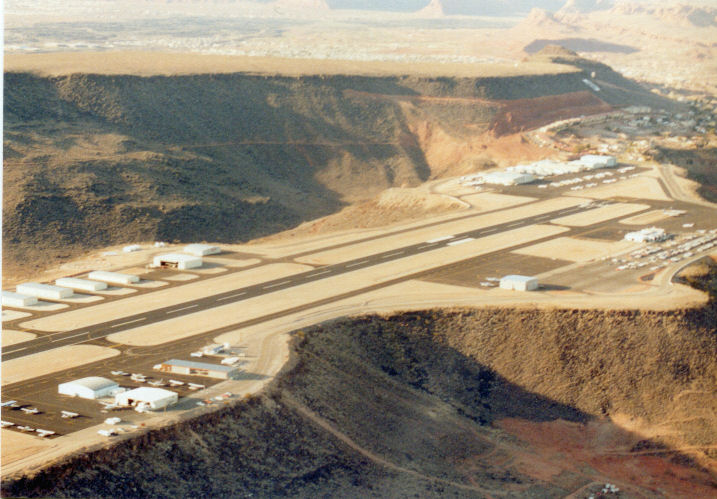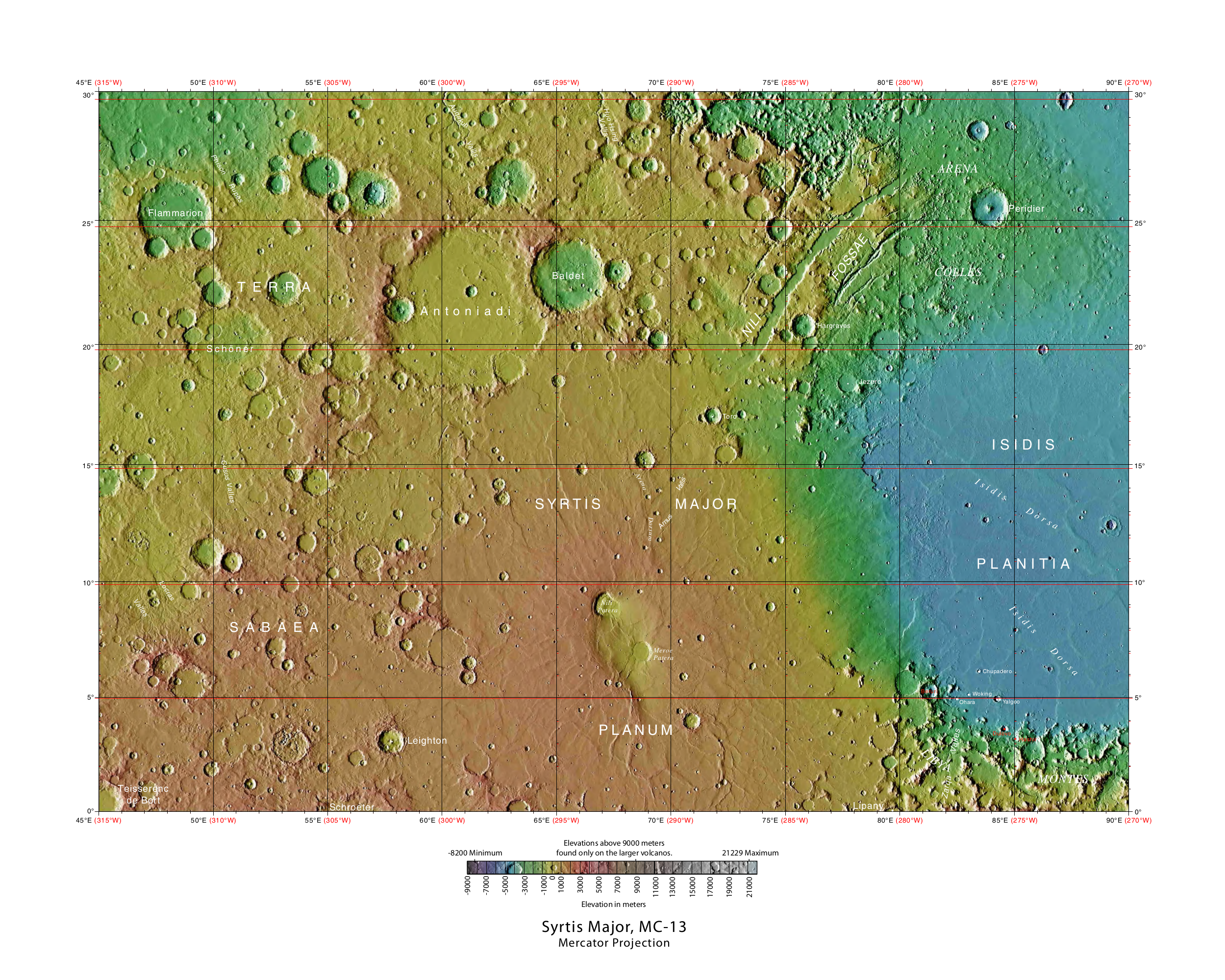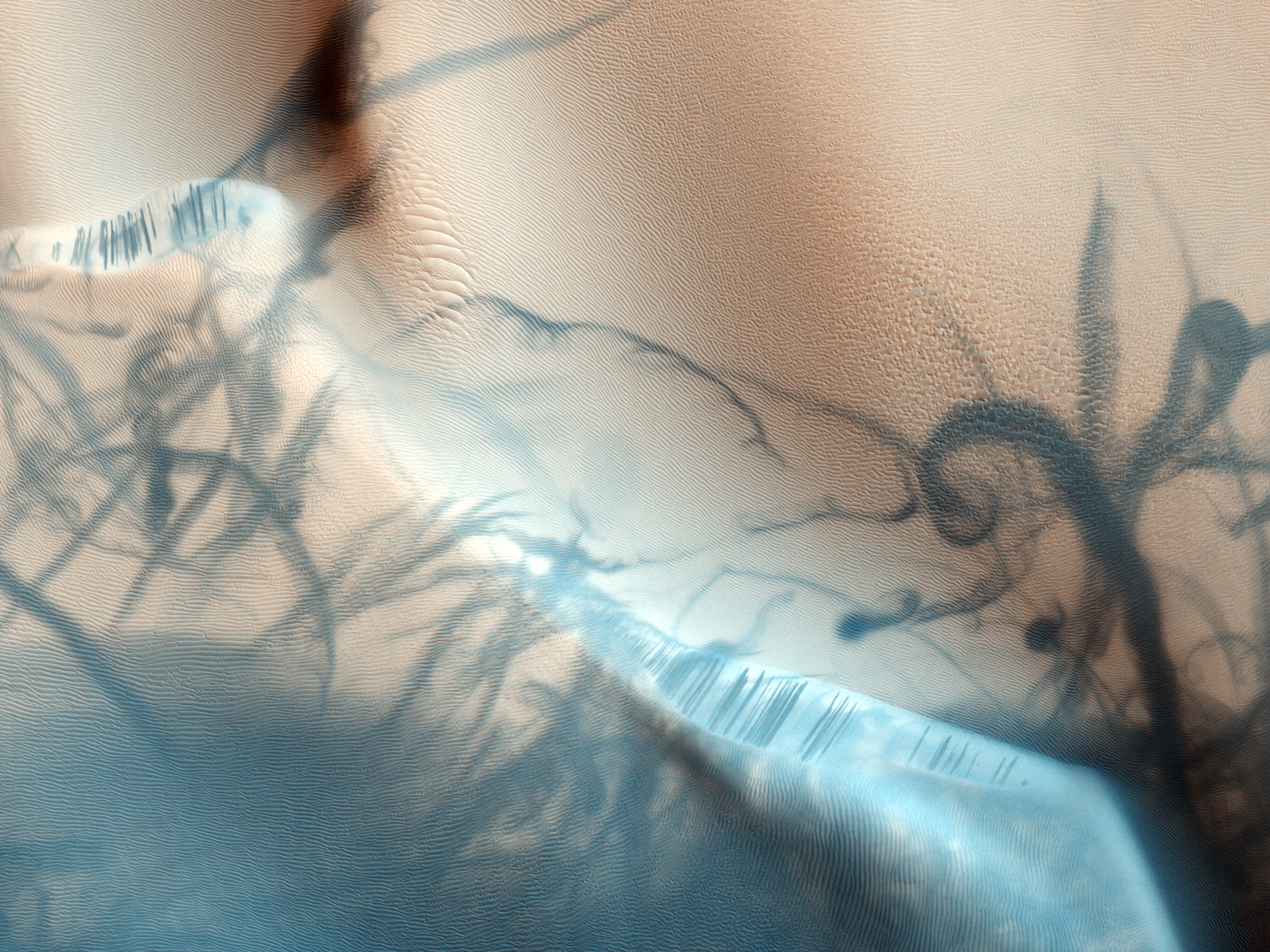|
Inverted Topography
Inverted relief, inverted topography, or topographic inversion refers to landscape features that have reversed their elevation relative to other features. It most often occurs when low areas of a landscape become filled with lava or sediment that hardens into material that is more resistant to erosion than the material that surrounds it. ''Differential erosion'' then removes the less resistant surrounding material, leaving behind the younger resistant material, which may then appear as a ridge where previously there was a valley. Terms such as "inverted valley" or "inverted channel" are used to describe such features.Pain, C.F., and C.D. Ollier, 1995, ''Inversion of relief - a component of landscape evolution.'' Geomorphology. 12(2):151-165. Inverted relief has been observed on the surfaces of other planets as well as on Earth. For example, well-documented inverted topographies have been discovered on Mars.Pain, C.F., J.D.A. Clarke, and M. Thomas, 2007, ''Inversion of relief on ... [...More Info...] [...Related Items...] OR: [Wikipedia] [Google] [Baidu] |
Inverted Channels Mars PIA08070
Inverse or invert may refer to: Science and mathematics * Inverse (logic), a type of conditional sentence which is an immediate inference made from another conditional sentence * Additive inverse (negation), the inverse of a number that, when added to the original number, yields zero * Compositional inverse, a function that "reverses" another function * Inverse element * Inverse function, a function that "reverses" another function **Generalized inverse, a matrix that has some properties of the inverse matrix but not necessarily all of them * Multiplicative inverse (reciprocal), a number which when multiplied by a given number yields the multiplicative identity, 1 ** Inverse matrix of an Invertible matrix Other uses * Invert level, the base interior level of a pipe, trench or tunnel * Inverse (website), ''Inverse'' (website), an online magazine * An outdated term for an LGBT person; see Sexual inversion (sexology) See also * Inversion (other) * Inverter (disambigua ... [...More Info...] [...Related Items...] OR: [Wikipedia] [Google] [Baidu] |
Table Mountain (Tuolumne County, California)
Table Mountain is a series of flat-topped hills in Tuolumne County, California that roughly parallels the modern Stanislaus River. These hills are capped by lava which flowed down from the crest of the Sierra Nevada 10.4 million years ago and hardened into a rock (latite) that is relatively resistant to erosion. The top of Table Mountain is composed of Table Mountain Latite, which formed from potassium-rich lavas erupted from a center of volcanism near modern-day Sonora Pass around 10.4 million years ago. Most outcrops on Table Mountain reveal flow-top breccias, while some outcrops show distinctive columnar jointing. Geology Initially, it was thought that Table Mountain had been formed by a dramatic inversion of the topography. This theory, first proposed in 1862 by William Brewer (a member of the Whitney Survey), suggested that the 10.4-million-year-old lava flow had followed the bottom of a bedrock valley cut by the ancestral Stanislaus River and then hardened, preserving the sh ... [...More Info...] [...Related Items...] OR: [Wikipedia] [Google] [Baidu] |
Syrtis Major Quadrangle
The Syrtis Major quadrangle is one of a series of 30 quadrangle maps of Mars used by the United States Geological Survey (USGS) Astrogeology Research Program. The Syrtis Major quadrangle is also referred to as MC-13 (Mars Chart-13). The quadrangle covers longitudes 270° to 315° west and latitudes 0° to 30° north on Mars. Syrtis Major quadrangle includes Syrtis Major Planum and parts of Terra Sabaea and Isidis Planitia. Syrtis Major is an old shield volcano with a central depression that is elongated in a north–south direction. It contains the calderas Meroe Patera and Nili Patera. Interesting features in the area include dikes and inverted terrain. The ''Beagle 2'' lander was about to land near the quadrangle, particularly in the eastern part of Isidis Planitia, in December 2003, when contact with the craft was lost. In January 2015, NASA reported the ''Beagle 2'' had been found on the surface in Isidis Planitia (location is about ). High-resolution images captured b ... [...More Info...] [...Related Items...] OR: [Wikipedia] [Google] [Baidu] |
HiRISE
High Resolution Imaging Science Experiment is a camera on board the ''Mars Reconnaissance Orbiter'' which has been orbiting and studying Mars since 2006. The 65 kg (143 lb), US$40 million instrument was built under the direction of the University of Arizona's Lunar and Planetary Laboratory by Ball Aerospace & Technologies Corp. It consists of a 0.5m (19.7 in) aperture reflecting telescope, the largest so far of any deep space mission, which allows it to take pictures of Mars with resolutions of 0.3m/pixel (1ft/pixel), resolving objects below a meter across. HiRISE has imaged Mars exploration rovers on the surface, including the ''Opportunity'' rover and the ongoing ''Curiosity'' mission. History In the late 1980s, of Ball Aerospace & Technologies began planning the kind of high-resolution imaging needed to support sample return and surface exploration of Mars. In early 2001 he teamed up with Alfred McEwen of the University of Arizona to propose such a c ... [...More Info...] [...Related Items...] OR: [Wikipedia] [Google] [Baidu] |
Aeolis Quadrangle
The Aeolis quadrangle is one of a series of 30 quadrangle maps of Mars used by the United States Geological Survey (USGS) Astrogeology Research Program. The Aeolis quadrangle is also referred to as MC-23 (Mars Chart-23). The Aeolis quadrangle covers 180° to 225° W and 0° to 30° south on Mars, and contains parts of the regions Elysium Planitia and Terra Cimmeria. A small part of the Medusae Fossae Formation lies in this quadrangle. The name refers to the name of a floating western island of Aeolos, the ruler of the winds. In Homer's account, Odysseus received the west wind Zephyr here and kept it in bags, but the wind got out. It is famous as the site of two spacecraft landings: the ''Spirit'' rover landing site () in Gusev crater (January 4, 2004), and the ''Curiosity'' rover in Gale Crater () (August 6, 2012). A large, ancient river valley, called Ma'adim Vallis, enters at the south rim of Gusev Crater, so Gusev Crater was believed to be an ancient lake bed. However, ... [...More Info...] [...Related Items...] OR: [Wikipedia] [Google] [Baidu] |
Mars Reconnaissance Orbiter
''Mars Reconnaissance Orbiter'' (MRO) is a spacecraft designed to study the geology and climate of Mars, provide reconnaissance of future landing sites, and relay data from surface missions back to Earth. It was launched on August 12, 2005, and reached Mars on March 10, 2006. In November 2006, after five months of aerobraking, it entered its final science orbit and began its primary science phase. The cost to develop and operate MRO through the end of its prime mission in 2010 was . The spacecraft continues to operate at Mars, far beyond its intended design life. Due to its critical role as a high-speed data-relay for ground missions, NASA intends to continue the mission as long as possible, at least through the late 2020s. Pre-launch After the twin failures of the ''Mars Climate Orbiter'' and the Mars Polar Lander missions in 1999, NASA reorganized and replanned its Mars Exploration Program. In October 2000, NASA announced its reformulated Mars plans, which reduced the numb ... [...More Info...] [...Related Items...] OR: [Wikipedia] [Google] [Baidu] |
Miyamoto (crater)
Miyamoto is a crater within the Margaritifer Sinus quadrangle (MC-19) region of the planet Mars, west of the Plains of Meridiani. It is wide. Its northeastern half is filled with rocks formed in the presence of water and include minerals of iron and sulfur, which likely settled on lake bottoms or in groundwater systems. In the southwestern half of the crater floor, erosion has stripped these materials away, revealing clays and other materials like those found in the most ancient Martian rocks. More than 3.5 billion years old, they date to the Noachian era at which time, liquid water was likely present at the surface and could have created an environment favorable to life. Miyamoto was considered as a possible landing site for the Mars Science Laboratory. Mars Science Laboratory Several sites in the Margaritifer Sinus quadrangle have been proposed as areas to send NASA's next major Mars rover, the Mars Science Laboratory. Miyamoto Crater was in the top seven sites chosen. ... [...More Info...] [...Related Items...] OR: [Wikipedia] [Google] [Baidu] |
Cape Fold Belt
The Cape Fold Belt is a fold and thrust belt of late Paleozoic age, which affected the sequence of sedimentary rock layers of the Cape Supergroup in the southwestern corner of South Africa. It was originally continuous with the Ventana Mountains near Bahía Blanca in Argentina, the Pensacola Mountains (East Antarctica), the Ellsworth Mountains (West Antarctica) and the Hunter-Bowen orogeny in eastern Australia. The rocks involved are generally sandstones and shales, with the shales (Bokkeveld Group) persisting in the valley floors while the erosion resistant sandstones (belonging to the Peninsula Formation) form the parallel ranges, the Cape Fold Mountains, which reach a maximum height of 2325 m at Seweweekspoortpiek ('Seven Weeks Defile Peak' in Afrikaans). The Cape Fold Mountains form a series of parallel ranges that run along the south-western and southern coastlines of South Africa for 850 km from the Cederberg 200 km to the north of the Cape Peninsula, a ... [...More Info...] [...Related Items...] OR: [Wikipedia] [Google] [Baidu] |
Cape Town
Cape Town ( af, Kaapstad; , xh, iKapa) is one of South Africa's three capital cities, serving as the seat of the Parliament of South Africa. It is the legislative capital of the country, the oldest city in the country, and the second largest (after Johannesburg). Colloquially named the ''Mother City'', it is the largest city of the Western Cape province, and is managed by the City of Cape Town metropolitan municipality. The other two capitals are Pretoria, the executive capital, located in Gauteng, where the Presidency is based, and Bloemfontein, the judicial capital in the Free State, where the Supreme Court of Appeal is located. Cape Town is ranked as a Beta world city by the Globalization and World Cities Research Network. The city is known for its harbour, for its natural setting in the Cape Floristic Region, and for landmarks such as Table Mountain and Cape Point. Cape Town is home to 66% of the Western Cape's population. In 2014, Cape Town was named the best place ... [...More Info...] [...Related Items...] OR: [Wikipedia] [Google] [Baidu] |
Table Mountain
Table Mountain ( naq, Huriǂoaxa, lit= sea-emerging; af, Tafelberg) is a flat-topped mountain forming a prominent landmark overlooking the city of Cape Town in South Africa. It is a significant tourist attraction, with many visitors using the cableway or hiking to the top. Table Mountain National Park is the most visited national park in South Africa, attracting 4.2 million people every year for various activities. The mountain has 8,200 plant species, of which around 80% are fynbos, meaning fine bush. It forms part of the Table Mountain National Park, and part of the lands formerly ranged by Khoe-speaking clans, such as the (the "High Clan"). It is home to a large array of mostly endemic fauna and flora. Features The main feature of Table Mountain is the level plateau approximately from side to side, edged by steep cliffs. The plateau, flanked by Devil's Peak to the east and by Lion's Head to the west, forms a dramatic backdrop to Cape Town. This broad sweep of mount ... [...More Info...] [...Related Items...] OR: [Wikipedia] [Google] [Baidu] |
Erosion A5
Erosion is the action of surface processes (such as water flow or wind) that removes soil, rock, or dissolved material from one location on the Earth's crust, and then transports it to another location where it is deposited. Erosion is distinct from weathering which involves no movement. Removal of rock or soil as clastic sediment is referred to as ''physical'' or ''mechanical'' erosion; this contrasts with ''chemical'' erosion, where soil or rock material is removed from an area by dissolution. Eroded sediment or solutes may be transported just a few millimetres, or for thousands of kilometres. Agents of erosion include rainfall; bedrock wear in rivers; coastal erosion by the sea and waves; glacial plucking, abrasion, and scour; areal flooding; wind abrasion; groundwater processes; and mass movement processes in steep landscapes like landslides and debris flows. The rates at which such processes act control how fast a surface is eroded. Typically, physical erosion proceeds ... [...More Info...] [...Related Items...] OR: [Wikipedia] [Google] [Baidu] |
Siltstone
Siltstone, also known as aleurolite, is a clastic sedimentary rock that is composed mostly of silt. It is a form of mudrock with a low clay mineral content, which can be distinguished from shale by its lack of fissility.Blatt ''et al.'' 1980, pp.381-382 Although its permeability and porosity is relatively low, siltstone is sometimes a tight gas reservoir rock, an unconventional reservoir for natural gas that requires hydraulic fracturing for economic gas production. Siltstone was prized in ancient Egypt for manufacturing statuary and cosmetic palettes. The siltstone quarried at Wadi Hammamat was a hard, fine-grained siltstone that resisted flaking and was almost ideal for such uses. Description There is not complete agreement on the definition of siltstone. One definition is that siltstone is mudrock ( clastic sedimentary rock containing at least 50% clay and silt) in which at least 2/3 of the clay and silt fraction is composed of silt-sized particles. Silt is defined a ... [...More Info...] [...Related Items...] OR: [Wikipedia] [Google] [Baidu] |









